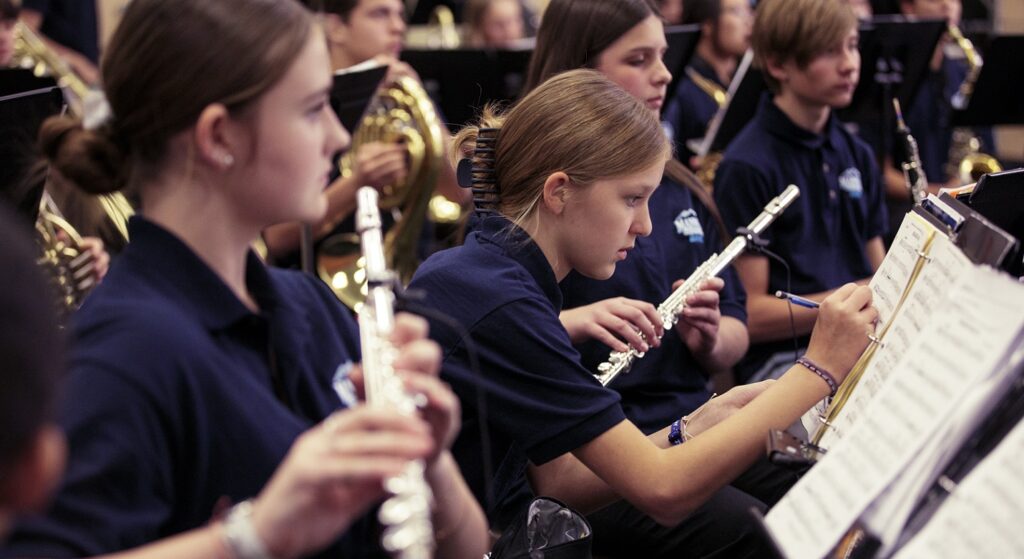Tagged Under:
Dig Deeper: How to Read Your School Accountability Report Card
Seek an understanding of your entire school and community by reviewing your school’s accountability report.
One of the most effective actions we can take as music teachers is to seek an understanding of our entire school and community and not just our music program.
An essential and often-overlooked document that we all have access to is the school report card, or school accountability report card (SARC). Most schools that receive state funding are required to publish an annual SARC to provide information about each school to parents and the community. These reports supply detailed information about a school’s makeup, programs and success rates. Although they vary by state, SARCs include student demographics and financial information.
Some schools and districts post their SARCs on their websites. If yours does not, you can easily find your school’s accountability report via an internet search of your state board of education or your school’s name and the words “report card.” Ensure that the report is official and not coming from a less-than-reputable source like a real estate website (some home-buying sites include arbitrary school rankings in listings). In most states, you can find your school report card as well as your district report card.
In my home state of Illinois, we have full school reports that are more than 20 pages long as well as an at-a-glance report that summarizes essential information on two pages. The full report provides options to explore five-year trends and comparisons with other schools.
Most SARCs contain the following information:
- Student demographic data
- Percentage of students on free or reduced lunch
- School and district spending per student
- Student mobility rate
- Class sizes
- Graduation rates
- Absentee and truancy rates
- Academic achievement
- Curriculum and instruction descriptions
- Postsecondary preparation information
- Faculty and staff information, including race and education
- School safety and climate for learning information
Dissecting Demographics and Asking Questions
There is a lot to unpack with a school report card. For this exercise, I looked at the 2019-2020 school report card for my school, Joliet Central High School. (This is the most recent report because most schools and districts did not have to release a SARC for 2020-2021 because of COVID-19.)
Look at my school’s at-a-glance report. Under the section marked “Fast Facts” at the top of the first page, I’m able to see the school’s total enrollment (3,275 students) and a breakdown of student races: 15% white, 18% Black, 63% Hispanic, 1% Asian, 1% American Indian and 3% two or more races. Of the total school population, 73% are considered low income, 11% are English Language Learners, 16% have an Individualized Education Plan (IEP) and 2% are homeless.
An interesting side note: The enrollment of Joliet Central does not match the demographics of the city of Joliet, which, according to the U.S. Census Bureau, is estimated at 66% white, 17% Black, 31% Hispanic or Latino, 2% Asian, 0.5% American Indian, and 3% from two or more races.
One of the first things I do is to break down the statistics on my SARC for some of the groups — 73% low income is easy for me to grasp, but 2% homeless is harder to understand. But once I do the math, I realize that we have 65 students at our school who are considered homeless. Further breakdown of the data shows that 360 students are learning English, and over 500 students require special services.
Some questions immediately come to mind. Does my music program or performing arts ensemble accurately represent my school? Does my school represent the community? If my program does not include students from each subgroup, why doesn’t it? Finally, what can I do to encourage or even allow participation?
It would be easy for me to focus on recruiting the 27% of students who are not categorized as low income, but that wouldn’t result in a band that is representative of my building. Because I have about nine feeder schools, my next step might be to explore their SARCs.
One of my feeder schools is 98% low income and 5% homeless. Racial/ethnic diversity is 6.1% white, 47.4% Black and 41.1% Hispanic. The total school population is 426 students. This school happens to be one of my smaller feeder programs. Music was cut at this school a few years ago, but it was recently brought back. The directors are working hard to build and grow their program. I have made an effort to visit this school more often, work with the band and talk about music opportunities at the high school level.
Enrollment in music from this particular feeder school has increased, and representation of each subgroup in my band are beginning to match the school more closely. I also find ways to increase the number of instruments I have on hand to supply to students who cannot afford to purchase or rent instruments.
I want to help other directors who face similar situations at their schools. If your band is missing representation from a particular race, the answer may not be as simple as going out to a feeder school more or playing music from their backgrounds. Strategies vary depending on your situation, but a good place to start is to reflect on whether your program is inviting and representative of all student groups. Also, look to invite guest musicians and speakers who are representative of your students.
Academic Achievement in All Areas
Do you have students who flourish in music but have average to below-average marks in their other classes? Celebrate them for their musical accomplishments but recommend them for additional help or tutoring. Academic achievement can be a critical area in a school report card. It plays a “significant role in predicting initial enrollment and retention in urban middle school band programs,” according to a study by Daryl W. Kinney on predictors of urban students’ decision to enroll in music.
At Joliet Central, students who do not reach a specific literacy benchmark as freshmen cannot take band, choir or orchestra because they need remedial support courses that take up an elective spot. Recently, our district was contemplating double math courses for all incoming freshmen who did not qualify for honors math. This would have resulted in these students having two elective spots taken up, nearly eliminating their performance music options during their freshman year. Stakeholders gave some feedback, and the decision to add more math was tabled.
Math scores, however, are essential, and the district is continuing to look at revisiting this idea or finding other options to provide support for these students. We’ve all heard that music helps math scores, but you can use your school report card to see actual data and correlation of data to help the students in your program and help advocate for your program.
Important Terms to Know
 You’ll have a much easier time reading your SARC if you understand the terms used. Some words and phrases are self-explanatory, but others can be confusing. Most SARCs have a reference guide or glossary. The 2020 Illinois Report Card Glossary of Terms is an 18-page document. The New York State Education Department’s is a little shorter, coming in at 11 pages. Listed below are some of the most relevant terms (descriptions have been simplified and summarized from the Illinois and New York glossaries). The legal definitions may vary in your state.
You’ll have a much easier time reading your SARC if you understand the terms used. Some words and phrases are self-explanatory, but others can be confusing. Most SARCs have a reference guide or glossary. The 2020 Illinois Report Card Glossary of Terms is an 18-page document. The New York State Education Department’s is a little shorter, coming in at 11 pages. Listed below are some of the most relevant terms (descriptions have been simplified and summarized from the Illinois and New York glossaries). The legal definitions may vary in your state.
- Student Group includes students who fall within a particular demographic or service group.
- Race/Ethnicity refers to the race in which the student primarily identifies as indicated by the student or the parent/guardian. Commonly included race/ethnicity groups include American Indian or Alaska Native, Asian or Native Hawaiian/Other Pacific Islander, Black or African American, Hispanic or Latino, white and multiracial.
- English Learners (ELs) are students who are eligible for bilingual education services. The percentage of EL students is the number of EL students divided by the total student enrollment multiplied by 100.
- Children with Disabilities include students who are identified as having a disability through formal evaluations and meet specific criteria, as stated under the Individuals with Disabilities Education Act (IDEA). A team that develops an Individualized Education Program (IEP) determines a student’s eligibility for special education and related services. A 504 Plan is for students with a disability who meet specific criteria as stated under Section 504 of the Rehabilitation Act of 1973. They may be eligible to receive accommodations and related services in a general education setting.
- Low-Income Students may receive or live in households that receive Supplemental Nutrition Assistance Program or Temporary Assistance to Needy Families benefits. They may also be homeless, migrant, runaway, Head Start or foster children. They may live in a household where the household income meets the U.S. Department of Agriculture income guidelines for free or reduced-price meals.
- Students with Individualized Education Programs are students who are eligible to receive special education services. The 14 special education categories are 1) intellectual disability, 2) hearing impairments, 3) speech or language impairments, 4) visual impairments, 5) emotional disability, 6) orthopedic impairments, 7) other health impairments, 8) specific learning disabilities, 9) deaf-blindness, 10) multiple disabilities, 11) autism, 12) traumatic brain injury, 13) developmental delay and 14) deafness.
- Military-Connected Students are students with a parent or guardian who is a member of the Armed Forces on active duty.
- Percent of Students Who Exceed, Meet or Do Not Meet Expectations/Standards, which was established by states’ boards of education, refers to the students’ distribution in the various performance levels based on their scores on the assessment.
- Percent of Teachers by Race/Ethnicity is the number of full-time equivalent classroom teachers belonging to particular racial/ethnic group as reported for the district, divided by the total number of full-time equivalent classroom teachers, multiplied by 100.
- Postsecondary Enrollment includes students who graduated with a regular high school diploma from a public high school in Illinois three years before the current school year and enrolled in a U.S. college within 12 or 16 months.
- Title 1 Status indicates whether a school is eligible for targeted or schoolwide supports according to Title 1.
- Schoolwide Title 1 Programs are for schools in which the poverty rate is 40 percent or higher.
- Targeted Assistance Programs are Title I schools with less than the 40 percent schoolwide threshold or schools that choose not to operate a schoolwide program. In short, the Title I assistance is not usable by every student in the school.
- Graduation Rate refers to students who begin and finish an education program. Four years is typical, but low-income area schools may encounter more fifth- and sixth-year graduates.
- Student Mobility Rate refers to students who transfer in and out of a school for reasons other than normal transitions (e.g., graduation).
- FRL stands for Free and Reduced Lunch. You may also see Free and Reduced Price Meals or similar terms.
- Homeless Students are children/youth who lack a fixed, regular and adequate nighttime residence. They may include students in shared housing, motels, camping grounds, shelters, cars, parks, hospitals or other private or public places not intended for residency.
- Instructional Expenditure per Pupil includes the direct costs of teaching pupils or the interaction between teachers and pupils.
- Annual Attendance Rate is typically determined by dividing the school’s (or district’s) total actual attendance by the total possible attendance for a school year. A school’s (or district’s) actual attendance is the sum of the number of students in attendance each day the school was open during the school year.
- Student Enrollment is the total student enrollment in the school and district.
- Chronic Absenteeism is typically determined by the number of chronically absent students, divided by the average daily enrollment of the responsible school and multiplied by 100.
- Dropout Rate is the rate of dropouts in an entity (school, district, state) per enrollment. Dropout refers to students who are expected to be enrolled but did not register. They did not graduate from high school or a state/district-approved educational program.
Compare Your Program to Your School Report Card
At Joliet Central High School, we have 125 students in the band, 100 in the orchestra and 85 in the choir. The school population is approximately 3,200, which means that the band comprises 3.9% of the student body, the orchestra 3.2% and the choir 2.6%. These are not impressive numbers in the scope of state and national averages, but it is what we can do with the resources, feeder programs and faculty that are in place.
When numbers allow, I always lean toward larger ensembles for a variety of reasons. Our auditioned group is larger than the popular wind ensembles found in many schools today. This considerable size is primarily because we prefer a large, symphonic sound, but an added benefit is that the size of this group (75-85 players) helps eliminate some emergencies. When attendance issues arise, a large ensemble creates a safety net from derailed performances due to missing parts. A larger group with multiple players per part (or numerous students learning a secondary part) will make the ensemble feel more comfortable if a soloist is not in attendance on the day of a performance.
Fostering the future is essential, so I try to have as close to 25% of the band come from each grade level (freshmen, sophomores, juniors and seniors). Some schools don’t allow freshmen in their auditioned ensembles, or they have separate bands for freshmen. I don’t have that option due to our numbers and program setup. Plus, I believe that allowing freshmen in a premiere group helps them to rapidly improve their skills.
Ted Lega, my high school band director when I attended Joliet Central High, would often take younger students and place them in between two experienced band members. I take this same approach today, and the results have been beneficial for the student and the band. We typically have around 10 students each year who move in, and five to 10 who move out. Placing newer or less experienced members with two mentors can help musical advancement and acclimate students to our school.
Answering the “Why”
Diversity is essential in education. Does your classroom represent your school? As a servant of your school, you have agreed to teach all members of your school. No one is asking you to change your class or audition process, but if you notice that your top ensemble tends to lean toward a certain income level or group, begin investigating why. You may also notice that students from lower income families gravitate toward certain instruments. I found the article “The Benefits of Socioeconomically and Racially Integrated Schools and Classrooms” from The Century Foundation to be extremely helpful in answering the “why” question.
Look at what programs you or your school can put in place to narrow the participation gap. It could be a simple solution. Summer programs, extra lessons or even a shift in the music you perform could help encourage or provide the musical experience for groups that may not have had this opportunity. More complicated situations can be at the core, however. Maybe your school has specific testing requirements for incoming students. For example, if students don’t hit a particular benchmark, they are then scheduled into a class that directly conflicts with music.
When you review your SARC, does anything in it surprise you? Does your program line up with the demographics of your school and community? Does your school line up with your community demographics? Are there student groups that need more representation in your classroom?
Your school report card is a useful tool to see your program and your school from a different perspective — take a look at yours today!
This content is from the book “High Needs, Monumental Successes: Teaching Music to Low-Income and Underserved Students” by Don Stinson. Copyright © 2021 GIA Publications, Inc. Reprinted with permission.2019_2020_JolietCentralHigh_SARC_AtAGlance















